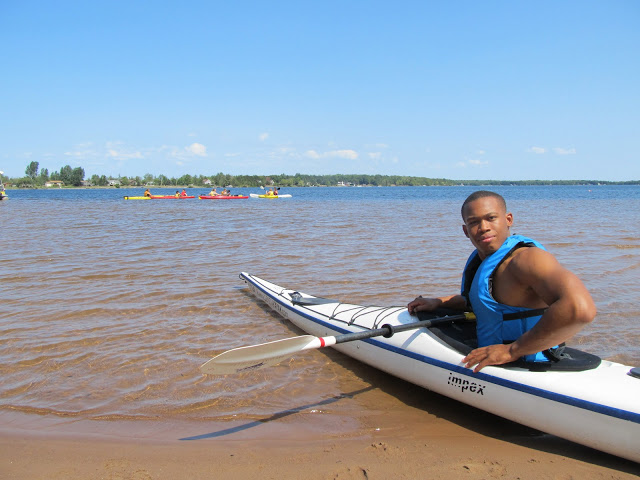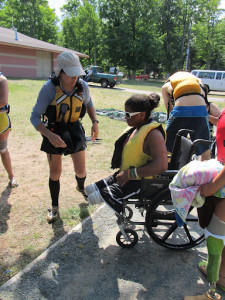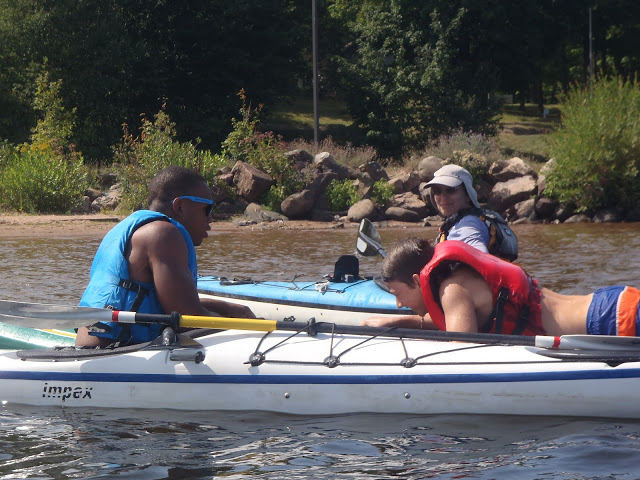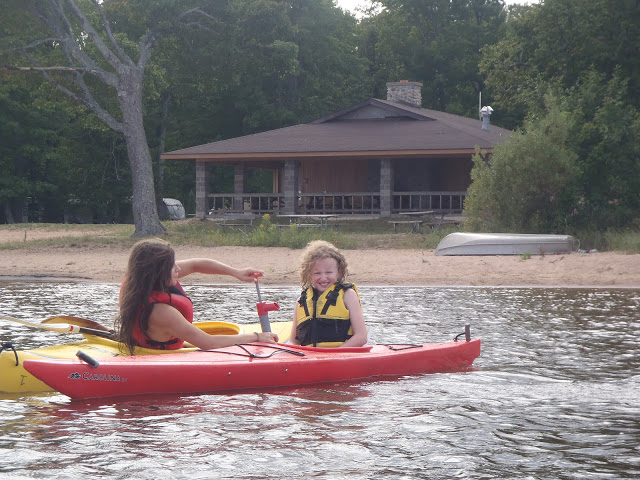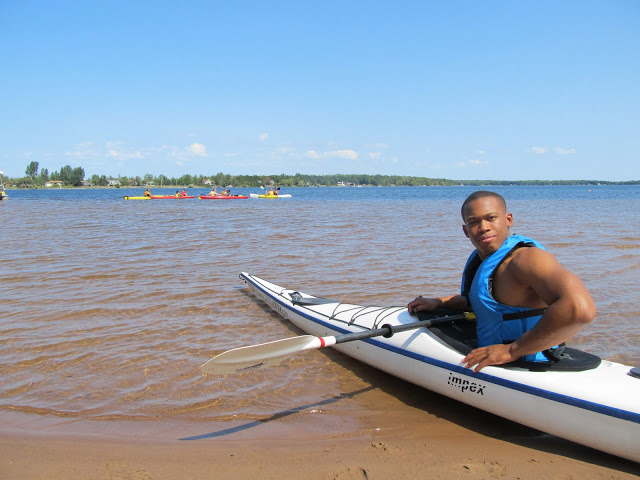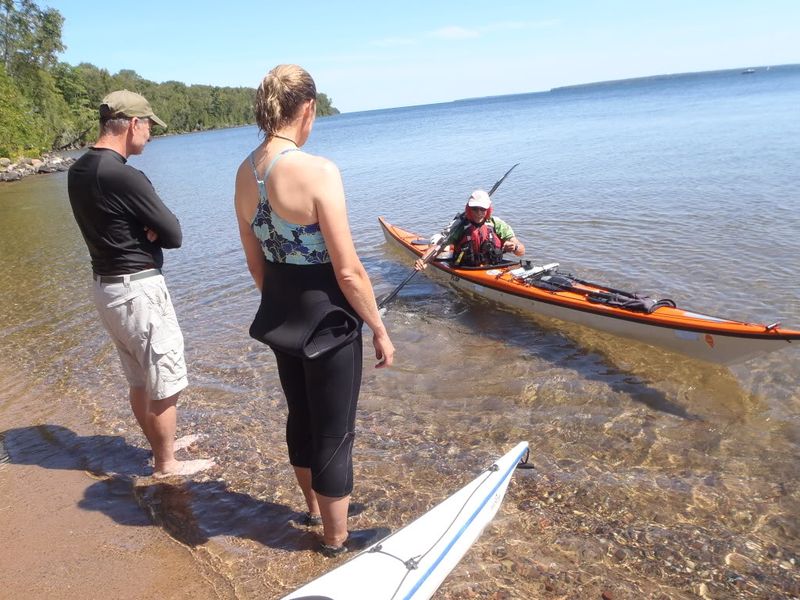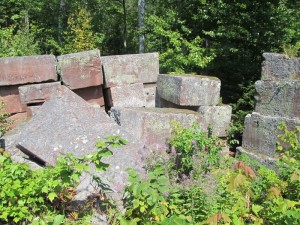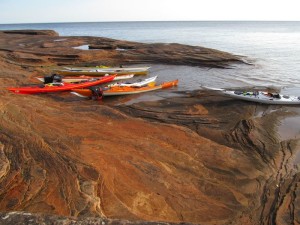Bay Cliff Health Camp “Camp Yes I Can” tucked up in beautiful Big Bay, Michigan on Lake Superior. Sam Crowley and Nancy Uschold of Sea Kayak Specialists, in nearby Marquette, have been a part of the Bay Cliff Health Camp kayaking program since 1994. In September they will be teaching a 4-day ACA Adaptive Paddling class there.
A line in the sand is quickly erased by wind and water
Which brings nature back to perfect order,
Unblemished by those who use a stick
To draw an imaginary limit on an issue, they pick.
Kayaking, basketball, and even horseback riding were just some of the activities at Bay Cliff Health Camp last week for boys and girls age 7-17. Forty campers and volunteer staff members participated this year, most were amputees. Through interacting with other amputees while enjoying the outdoors, the purpose of the camp is to help the campers gain confidence as well as become more comfortable with their prosthetic limbs.
During the Great Depression, two female health professionals, one a nurse and the other a physician, traveled throughout Michigan’s Upper Peninsula caring for children who were malnourished and underweight due to the times. As they continued to see the effects of poor nutrition on the children’s health, they conspired together to do more. They envisioned a place where the children could be outdoors in the fresh air and sunshine, be fed well three times a day, and be involved in camping experiences…. (Bay Cliff History)
Nearly 1 in every 3 Americans lived on the farm in 1930. Due to the Great Depression, a dairy farm that had been abandoned was found just 27 miles northwest of Marquette, in Big Bay. Contributions where raised and soon the farm was officially incorporated as Bay Cliff Health Camp, a non-profit, non-denominational camp for children.
(Nancy coaching a re-entry with a smile.)
In 1934, during the first program, the underweight children not only gained an average of 5 pounds, but through organized staff their summer was filled with camping fun. Later, although nutritional needs eased a bit as the country moved out of the Great Depression, an outbreak of polio in the summer of 1940 rampaged through the Upper Peninsula leaving hundreds of children paralyzed and crowding the hospitals. The polio epidemic changed the focus of the camp to serve not only malnourished, but physically disabled children and it has been a therapy camp ever since.
Between 1940-1970 the increased use of machinery, new crop varieties, better pesticides and fertilizers all allowed more people to leave the farms. Before the 1950s, fresh vegetables had been only available during the short local growing season. As more people began to own cars and new road systems allowed better transportation of produce and dairy products, new technology increased the production of food as well as better ways of preserving food.
The most feared public-health threat in the United States, polio, still hovered over every common activity during this time. In 1952, a record 57,628 cases were reported. It took more lives every year than any other communicable disease. Jonas Salk, a virologist working at the University of Pittsburgh with support from the Sarah Scaife Foundation, started testing a polio vaccine—bravely beginning with himself and his family. When he publicly announced his breakthrough, more than two million children signed up for the trial. The vaccine was declared safe for the public in 1955. This polio vaccine ended the spread of polio and later, vaccines were developed against measles, mumps, diphtheria, tetanus, whooping cough, and other diseases.
Because children continue to face physical challenges either at birth or through their development today, Bay Cliff Health Camp serves them just the same. Today, children with physical disabilities such as cerebral palsy, muscular dystrophy, spina bifida, vision impairment, hearing loss, arthritis, joint deformities, limb loss, and disability due to accidents or trauma, to name a few, can all experience the Bay Cliff Health Camp.
Kelly Allen, who was in our kayak classes last week, was born with a proximal femoral focal deficiency. Kelly is a two-time gold medalist in women’s kayaking:
“Allen’s athletic abilities have taken her to international competitions such as the Extremity Games. ‘What they want it to be is like the equivalent of what the X-Games is for people with prosthetics or orthotics,’ Allen said. The Extremity Games host events in skateboarding, rock climbing, kayaking, wakeboarding, mountain biking, motocross and martial arts. When Allen began to attend the Extremity Games, she was the youngest competitor. Now, four years later, she has won a silver medal in rock climbing and is a two-time gold medalist in women’s kayaking. The Extremity Games not only provide Allen with an opportunity to compete, but give her a chance to be with people and athletes who have limb deficiencies like hers.” Marquette Monthly
Kelly is currently ranked 15th in the NASTAR Three Track Skier Division and working toward earning a spot at the 2014 Paralympics. She is a not only a well-rounded athlete, but a great role model for young girls everywhere. Story here.
Jim Tibensky was named the “Paddler of the year in 2007” by the Illinois Paddling Council. He discovered paddling in Boy Scouts. He also shared with me that, since he had polio, he was introduced to the pool and swimming at an early age and was a good swimmer due to that.
Between 1968-1994 Jim won seven state championships, twenty-five Midwest division championships and eight national championships. He was the course designer for two World Cup races, three Champion International Slalom Series, and two National Championship races that were held in Wausau, Wisconsin and South Bend, Indiana.
In 1996 he officiated as a Scribe at the Atlanta Olympic Games. Since 1998, he has been the head kayak guide for week long sea kayak trips offered through Omni Youth Services of Illinois, a wilderness therapy program that serves the youth and families of Chicago’s Northwest suburbs.
A year ago in April, Jim co-authored an article for Sea Kayaker Magazine with Andrea Knepper about wilderness therapy for young people, “A Whole New World: Kayaking as Therapy For Kids.” Kayak trips provide a special environment for change that is not a part of other more land-based forms of wilderness therapy.
(Brownstone Quarry remains; Apostle Islands.)
Jim’s interests in anthropology made our trip more interesting, too. He shared a lot of information with us on many subjects, actually. I did not prepare for this year’s trip beyond getting the nautical map and focusing on my paddling, so it was refreshing to have him not only share his insights along the way, but instigate our exploring of the area more. We purposefully stopped by the Hermit Island quarry because he was interested. Sandstone from the Apostles helped rebuild Chicago after the Great Fire. Entire city blocks in Chicago and other Midwestern cities are constructed with the brownstone from quarries on some of the islands. Hermit Island has the best remaining quarry remnants.
Hermit and Stockton Islands are most noted for black bear in the Apostles, Stockton having the greatest concentration in the United States. Blueberries are abundant on the island and may be the reason why the bears like it there so well. They also love mealy ants and worms so if you see torn-up or turned-over logs most likey it was from a bear.
(Devils Island.)
Devils Island is as far north as Wisconsin goes. Rough waters and pounding waves have created the Devils Island Cliffs State Natural Area. Five acres of exposed cliff include blowholes and bluff-top boreal forests.
My brother was diagnosed with chronic Multiple Sclerosis when he was in his mid-30s. I remember when he lived with my husband and I for a season while he was still able to drive and he was really excited about a man who was encouraging him to work to strengthen his muscles by doing exercises. Within ten years, my brother was not able to do that anymore.
Drawing A Line in the Sand
Did you ever think how meaningless it is
When someone has a cause
And says, ‘I’ve drawn a line in the sand! ‘
As if this has meaning to their fellow man.
A line in the sand is quickly erased by wind and water
Which brings nature back to perfect order,
Unblemished by those who use a stick
To draw an imaginary limit on an issue, they pick.
They, like their cause will fade from sight
As the mark created for their own delight,
To impress like minded ones that they’ve been there,
And that they, ‘Really Care! ‘
If they had the courage of their convictions,
It would be ‘Etched in Stone’ without correction.
There for all to see and remember that once
Passed this way was one, who now is gone,
But made a mark for others to see
That’s recorded permanently.
A visit to the resting place
Of those who served in the Nation’s grace.
Lived and died so that all could share
The freedom they gave up without a care.
Those stones that stand so silent and tall;
On them are etched words to remind us all
That freedom is not free
And another sacrificed his (or hers) for you and me.
Sidi J. Mahtrow

